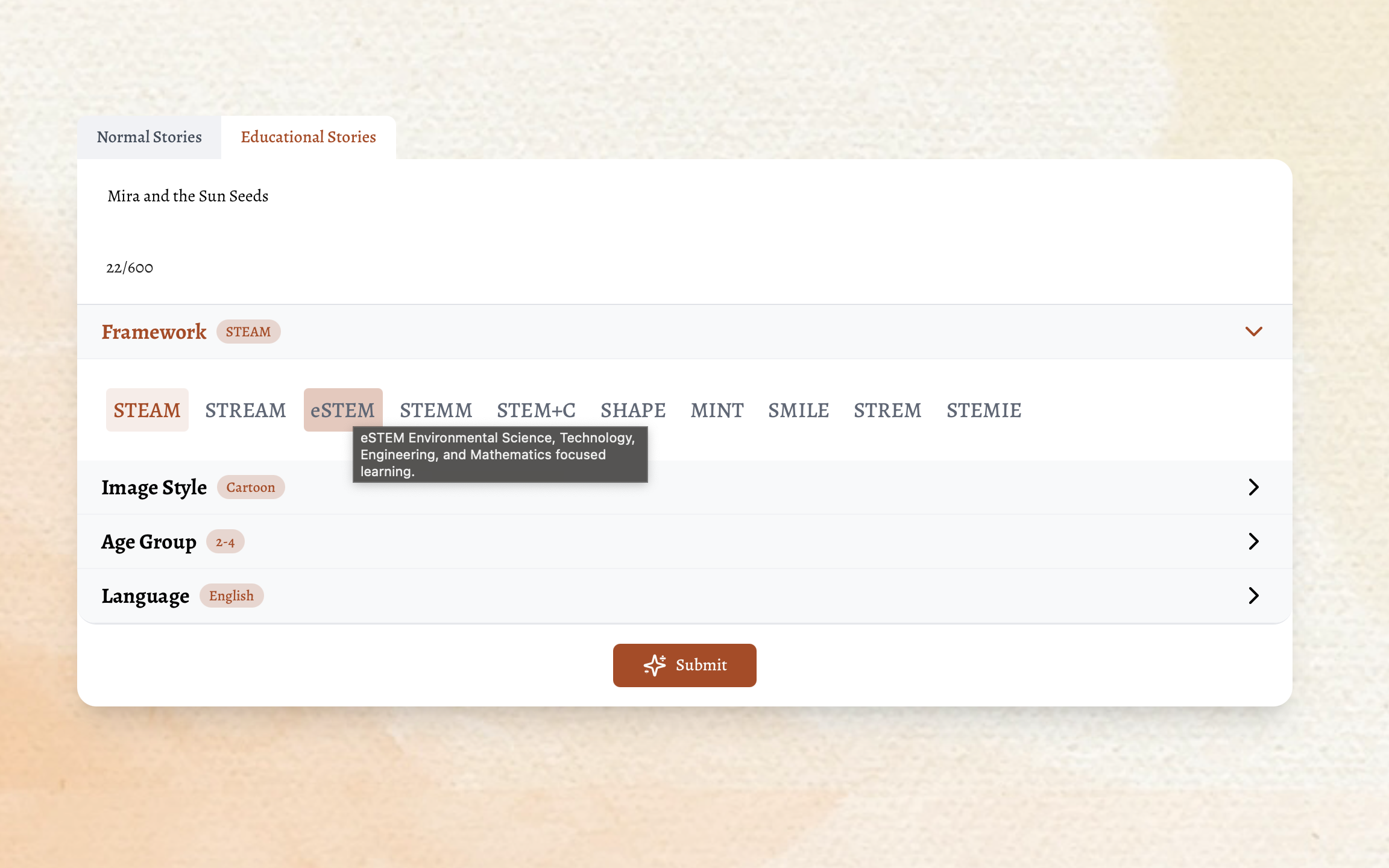How to Use StoryBee AI to Create Educational Content Aligned with STEM & STEAM Frameworks
Introduction: Bringing Learning to Life Through Stories
Storytelling has always been one of the most powerful ways to teach. With StoryBee AI, educators can now merge creativity with structured learning by generating interactive stories aligned with [global educational frameworks such as STEM (Science, Technology, Engineering, Mathematics) and STEAM (Science, Technology, Engineering, Arts, Mathematics).
These frameworks help students develop curiosity, problem-solving skills, and creativity all through the magic of storytelling.
1. The Power of Story-Based Learning
Children retain and understand ideas better when lessons are told as stories. StoryBee allows teachers to design stories that embed real learning concepts within engaging narratives.
Examples include:
- A young inventor building a solar-powered robot to learn about renewable energy.
- A magical forest where shapes and numbers come alive, reinforcing geometry and spatial reasoning.
- A curious explorer learning cause and effect through science experiments that shape the world around them.
By merging imagination and curriculum goals, StoryBee turns abstract concepts into memorable learning experiences.

2. Choosing an Educational Framework: STEM or STEAM
-
STEM (Science, Technology, Engineering, Mathematics): Focuses on logic, innovation, and analytical thinking. Ideal for lessons in coding, robotics, or physics. Example Story: “Luna and the Code Garden” - A tale that teaches logic loops through an enchanted forest of programs.
-
STEAM (Science, Technology, Engineering, Arts, Mathematics): Adds creativity, design, and artistic expression to analytical skills. Perfect for lessons that mix art, storytelling, and technology. Example Story: “Ava’s Rainbow Circuit” - A story combining color theory and simple electronics to teach creative problem-solving.
3. How to Create Educational Stories on StoryBee
Creating learning-based stories with StoryBee is easy and doesn’t require any prior technical skill.
Steps to get started:
-
Visit storybee.app.
-
Select the age group and learning theme you want to focus on for example, environment, math, or creative arts.
-
Add characters and settings that relate to the topic.
- Example: A young scientist exploring gravity or an artist painting sound waves.
-
Define your learning outcomes in the story prompt.
- Example: “Help students understand how plants convert sunlight into energy.”
-
Generate the story using StoryBee AI complete with illustrations and optional AI voice narration.
-
Share or print your story using StoryBee’s classroom sharing or print-on-demand features.
4. Using StoryBee in Classrooms
StoryBee can easily fit into your lesson plans. Teachers can integrate it in multiple ways:
-
Before a Lesson: Begin with a story that introduces the core topic (e.g., gravity, renewable energy, or problem-solving).
-
Collaborative Creation: Encourage students to co-create a story around what they learned that week. StoryBee supports collaborative inputs for shared storytelling.
-
Listening Practice: Use StoryBee’s AI voice narration to improve listening comprehension and pronunciation.
-
Creative Exercises: Ask students to illustrate story scenes, write alternative endings, or record their own narration for the generated stories.
5. Example Educational Story Ideas
Here are a few ready-to-use ideas for inspiration:
-
Energy & Environment (STEM): “Mira and the Sun Seeds” - A story about learning renewable energy through solar-powered plants.
-
Space Exploration (STEM): “Orion’s Journey Beyond the Moons” - Introduces gravity, orbit, and space discovery in an adventurous context.
-
Art & Technology (STEAM): “Pixel Painter” - A creative fusion of digital art, symmetry, and math patterns.
-
Human Emotions & Design (STEAM): “The Empathy Machine”- A story exploring design thinking and emotional intelligence.
6. Why StoryBee Works for Educators
- Customizable: Stories can be adapted to different grade levels, subjects, and frameworks.
- Multimodal Learning: Combines text, visuals, and audio engaging visual, auditory, and kinesthetic learners alike.
- Safe and Private: Designed with child safety and privacy at its core.
- Globally Applicable: STEM and STEAM alignment ensures stories are suitable for classrooms worldwide.
7. Bringing Education and Imagination Together
StoryBee is more than just a storytelling platform it’s a space where imagination becomes a bridge to understanding. Whether you’re teaching science, design, or empathy, every concept can be transformed into a magical story that students remember.
Start creating your classroom adventures today: 👉 Create your first educational story
